Laser-Induced Forward Transfer with Optical Stamp of a Protein-Immobilized Calcium Phosphate Film Prepared by Biomimetic Process to a Human Dentin
Abstract
Featured Application
Abstract
1. Introduction
2. Experimental
2.1. Preparation of Fn-CaP Donor Films on Optical Stamp Using the Biomimetic Process
2.2. LIFTOP Process for the Rapid Printing of Fn-CaP Films
2.3. Surface Morphology Evaluation of the Donor Films and Transferred Fn-CaP Microchips on the PET and Human Dentin Receiver Substrates
2.4. Cross-Sectional Observation of the Transferred Fn-CaP Microchips on the Human Dentin Receiver
3. Results and Discussion
3.1. Donor Film Characterization
3.2. Optical Stamp Effects on the Film Transfer
3.3. A Model for the LIFTOP Process of the Fn-CaP Film
3.4. Rapid and Area-Specific Printing of Fn-CaP Microchips onto Human Dentin Surface
3.5. Surface and Interface Observation of the Fn-CaP Microchips Printed on the Dentin Substrate
3.6. Potential of the LIFTOP Process
4. Conclusions
Author Contributions
Funding
Acknowledgments
Conflicts of Interest
References
- Bohandy, J.; Kim, B.F.; Adrian, F.J. Metal deposition from a supported metal film using an excimer laser. J. Appl. Phys. 1986, 60, 1538–1539. [Google Scholar] [CrossRef]
- Feinaeugle, M.; Pohl, R.; Bor, T.; Vaneker, T.; Römer, G. Printing of complex free-standing microstructures via laser-induced forward transfer (LIFT) of pure metal thin films. Addit. Manufact. 2018, 24, 391–399. [Google Scholar] [CrossRef]
- Zenou, M.; Sa’ar, A.; Kotler, Z. Supersonic laser-induced jetting of aluminum micro-droplets. Appl. Phys. Lett. 2015, 106, 181905. [Google Scholar] [CrossRef]
- Banks, D.P.; Grivas, C.; Mills, J.D.; Eason, R.W.; Zergioti, I. Nanodroplets deposited in microarrays by femtosecond Ti:sapphire laser-induced forward transfer. Appl. Phys. Lett. 2006, 89, 193107. [Google Scholar] [CrossRef]
- Nakata, Y.; Hayashi, E.; Tsubakimoto, K.; Miyanaga, N.; Narazaki, A.; Shoji, T.; Tsuboi, Y. Nanodot array deposition via single shot laser interference pattern using laser-induced forward transfer. Int. J. Extrem. Manufact. 2020, 2, 025101. [Google Scholar] [CrossRef]
- Narazaki, A.; Sato, T.; Kurosaki, R.; Kawaguchi, Y.; Niino, H. Nano- and microdot array formation of FeSi2 by nanosecond excimer laser-induced forward transfer. Appl. Phys. Express 2008, 1, 057001. [Google Scholar] [CrossRef]
- Baum, M.; Kim, H.; Alexeev, I.; Piqué, A.; Schmidt, M. Generation of transparent conductive electrodes by laser consolidation of LIFT printed ITO nanoparticle layers. Appl. Phys. A 2013, 111, 799–805. [Google Scholar] [CrossRef]
- Narazaki, A.; Kurosaki, R.; Sato, T.; Niino, H. On-demand patterning of indium tin oxide microdots by laser-induced dot transfer. Appl. Phys. Express 2013, 6, 092601. [Google Scholar] [CrossRef]
- Narazaki, A.; Kurosaki, R.; Sato, T.; Niino, H. On-demand deposition of functional oxide microdots by double-pulse laser-induced dot transfer. J. Laser Micro/Nanoeng. 2014, 9, 10–14. [Google Scholar] [CrossRef]
- Breckenfeld, E.; Kim, H.; Auyeung, R.C.Y.; Charipar, N.; Serra, P.; Piqué, A. Laser-induced forward transfer of silver nanopaste for microwave interconnects. Appl. Surf. Sci. 2015, 331, 254–261. [Google Scholar] [CrossRef]
- Piqué, A.; Auyeung, R.C.Y.; Kim, H.; Charipar, N.; Mathews, S.A. Laser 3D micro-manufacturing. J. Phys. D Appl. Phys. 2016, 49, 223001. [Google Scholar] [CrossRef]
- Tsakona, D.; Theodorakos, I.; Kalaitzis, A.; Zergioti, I. Investigation on high speed laser printing of silver nanoparticle inks on flexible substrates. Appl. Surf. Sci. 2020, 513, 145912. [Google Scholar] [CrossRef]
- Smits, E.C.P.; Walter, A.; de Leeuw, D.M.; Asadi, K. Laser induced forward transfer of graphene. Appl. Phys. Lett. 2017, 111, 173101. [Google Scholar] [CrossRef]
- Sorkio, A.; Koch, L.; Koivusalo, L.; Reiwick, A.; Miettinen, S.; Chichkov, B.; Skottman, H. Human stem cell based corneal tissue mimicking structures using laser-assisted 3D bioprinting and functional bioinks. Biomaterials 2018, 171, 57–71. [Google Scholar] [CrossRef] [PubMed]
- Leva, V.; Chatzipetrou, M.; Alexopoulos, L.; Tzeranis, D.S.; Zergioti, I. Direct laser printing of liver cells on porous collagen scaffolds. J. Laser Micro/Nano-Eng. 2018, 13, 234–237. [Google Scholar]
- Narazaki, A.; Oyane, A.; Komuro, S.; Kurosaki, R.; Kameyama, T.; Sakamaki, I.; Araki, H.; Miyaji, H. Bioactive micropatterning of apatite immobilizing cell adhesion protein by laser-induced forward transfer with a shock absorber. Opt. Mater. Express 2019, 9, 2807–2816. [Google Scholar] [CrossRef]
- Auyeung, R.C.Y.; Kim, H.; Mathews, S.; Piqué, A. Laser forward transfer using structured light. Opt. Express 2015, 23, 422–430. [Google Scholar] [CrossRef]
- Turkoz, E.; Perazzo, A.; Deike, L.; Stone, H.A.; Arnold, C.B. Deposition-on-contact regime and the effect of donor-acceptor distance during laser-induced forward transfer of viscoelastic liquids. Opt. Mater. Express 2019, 9, 2738–2747. [Google Scholar] [CrossRef]
- Shugaev, M.V.; Bulgakova, N.M. Thermodynamic and stress analysis of laser-induced forward transfer of metals. Appl. Phys. A 2010, 101, 103–109. [Google Scholar] [CrossRef]
- Röder, T.C.; Köhler, J.R. Physical model for the laser induced forward transfer process. Appl. Phys. Lett. 2012, 100, 071603. [Google Scholar] [CrossRef]
- Pohl, R.; Visser, C.W.; Römer, G.R.B.E.; Sun, C.; Huis in’t Veld, A.J.; Lohse, D. Imaging of the ejection process of nanosecond laser-induced forward transfer of gold. J. Laser Micro/Nanoeng. 2015, 10, 154–157. [Google Scholar] [CrossRef]
- Pohl, R.; Visser, C.W.; Römer, G.R.B.E.; Lohse, D.; Sun, C.; Huisin’t Veld, B. Ejection regimes in picosecond laser-induced forward transfer of metals. Phys. Rev. Appl. 2015, 3, 024001. [Google Scholar] [CrossRef]
- Habraken, W.; Habibovic, P.; Epple, M.; Bohner, M. Calcium phosphates in biomedical applications: Materials for the future? Mater. Today 2016, 19, 69–87. [Google Scholar] [CrossRef]
- Das, P.; Jana, N.R. Length-controlled synthesis of calcium phosphate nanorod and nanowire and application in intracellular protein delivery. ACS Appl. Mater. Interfaces 2016, 8, 8710–8720. [Google Scholar] [CrossRef] [PubMed]
- Cai, Z.; Wang, X.; Zhang, Z.; Han, Y.; Luo, J.; Huang, M.; Zhang, B.; Hou, Y. Large-scale and fast synthesis of nano-hydroxyapatite powder by a microwave-hydrothermal method. RCS Adv. 2019, 9, 13623–13630. [Google Scholar] [CrossRef]
- Dorozhkin, S.V. Nanodimensional and nanocrystalline apatites and other calcium orthophosphates in biomedical engineering, biology and medicine. Materials 2009, 2, 1975–2045. [Google Scholar] [CrossRef]
- García-sanz, F.J.; Mayor, M.B.; Arias, J.L.; Pou, J.; Leon, B.; Pérez-amor, M. Hydroxyapatite coatings: A comparative study between plasma-spray and pulsed laser deposition techniques. J. Mater. Sci. Mater. Med. 1997, 8, 861–865. [Google Scholar] [CrossRef]
- Blinda, O.; Kleinb, L.H.; Daileya, B.; Jordan, L. Characterization of hydroxyapatite films obtained by pulsed-laser deposition on Ti and Ti-6AL-4v substrates. Dent. Mater. 2005, 21, 1017–1024. [Google Scholar] [CrossRef]
- Rau, J.V.; Cacciotti, I.; Laureti, S.; Fosca, M.; Varvaro, G.; Latini, A. Bioactive, nanostructured Si-substituted hydroxyapatite coatings on titanium prepared by pulsed laser deposition. J. Biomed. Mater. Res. 2015, 103, 1621–1631. [Google Scholar] [CrossRef]
- Oyane, A.; Wang, X.P.; Sogo, Y.; Ito, A.; Tsurushima, H. Calcium phosphate composite layers for surface-mediated gene transfer. Acta Biomater. 2012, 8, 2034–2046. [Google Scholar] [CrossRef]
- Oyane, A.; Sakamaki, I.; Shimizu, Y.; Kawaguchi, K.; Koshizaki, N. Liquid-phase laser process for simple and area-specific calcium phosphate coating. J. Biomed. Mater. Res. 2012, 100A, 2573–2580. [Google Scholar] [CrossRef] [PubMed]
- Oyane, A.; Murayama, M.; Yamazaki, A.; Sogo, Y.; Ito, A.; Tsurushima, H. Fibronectin–DNA–apatite composite layer for highly efficient and area-specific gene transfer. J. Biomed. Mater. Res. 2010, 92A, 1038–1047. [Google Scholar] [CrossRef] [PubMed]
- Oyane, A.; Sakamaki, I.; Koga, K.; Nakamura, M.; Shitomi, K.; Miyaji, H. Antibacterial tooth surface created by laser-assisted pseudo-biomineralization in a supersaturated solution. Mater. Sci. Eng. 2020, 116, 111170. [Google Scholar] [CrossRef] [PubMed]
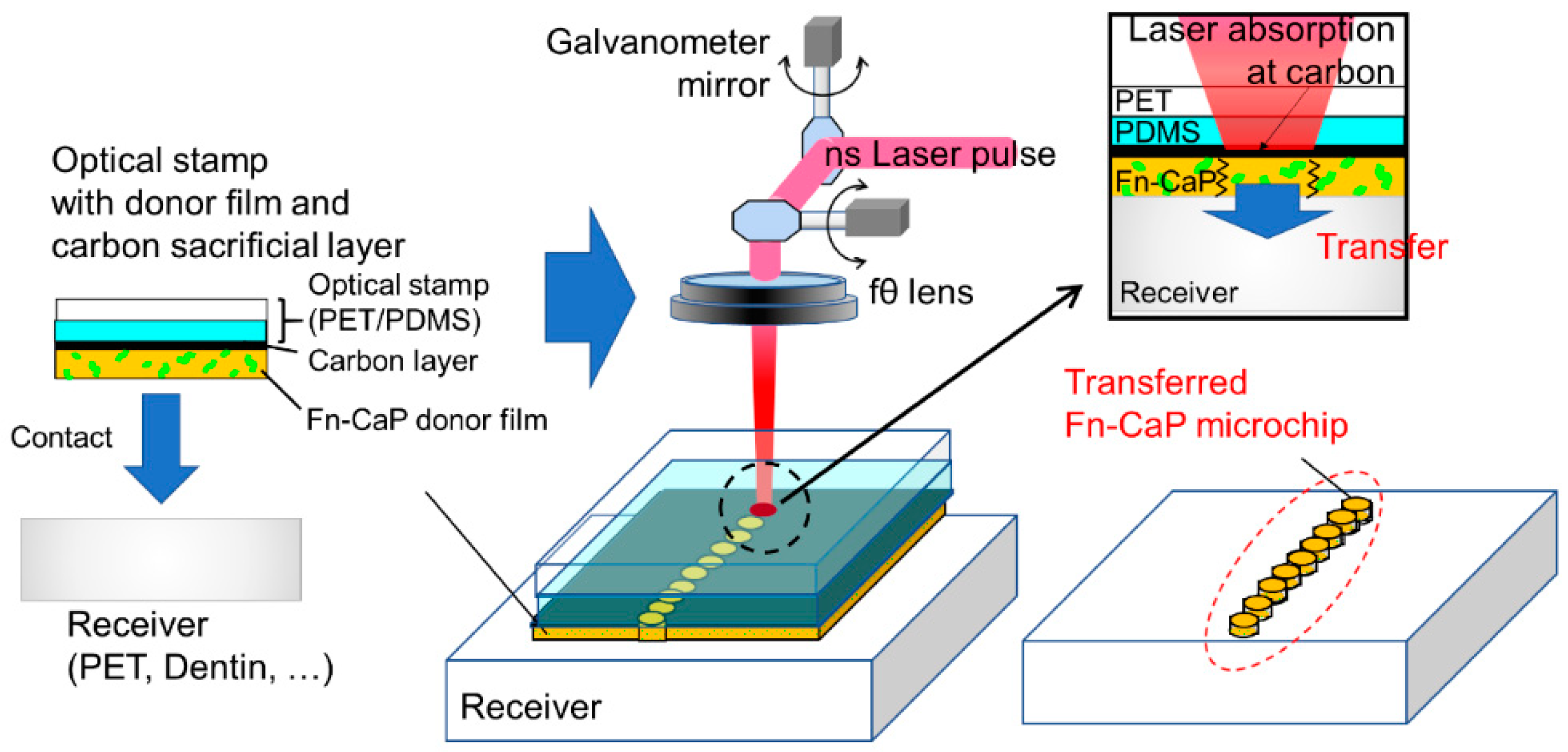
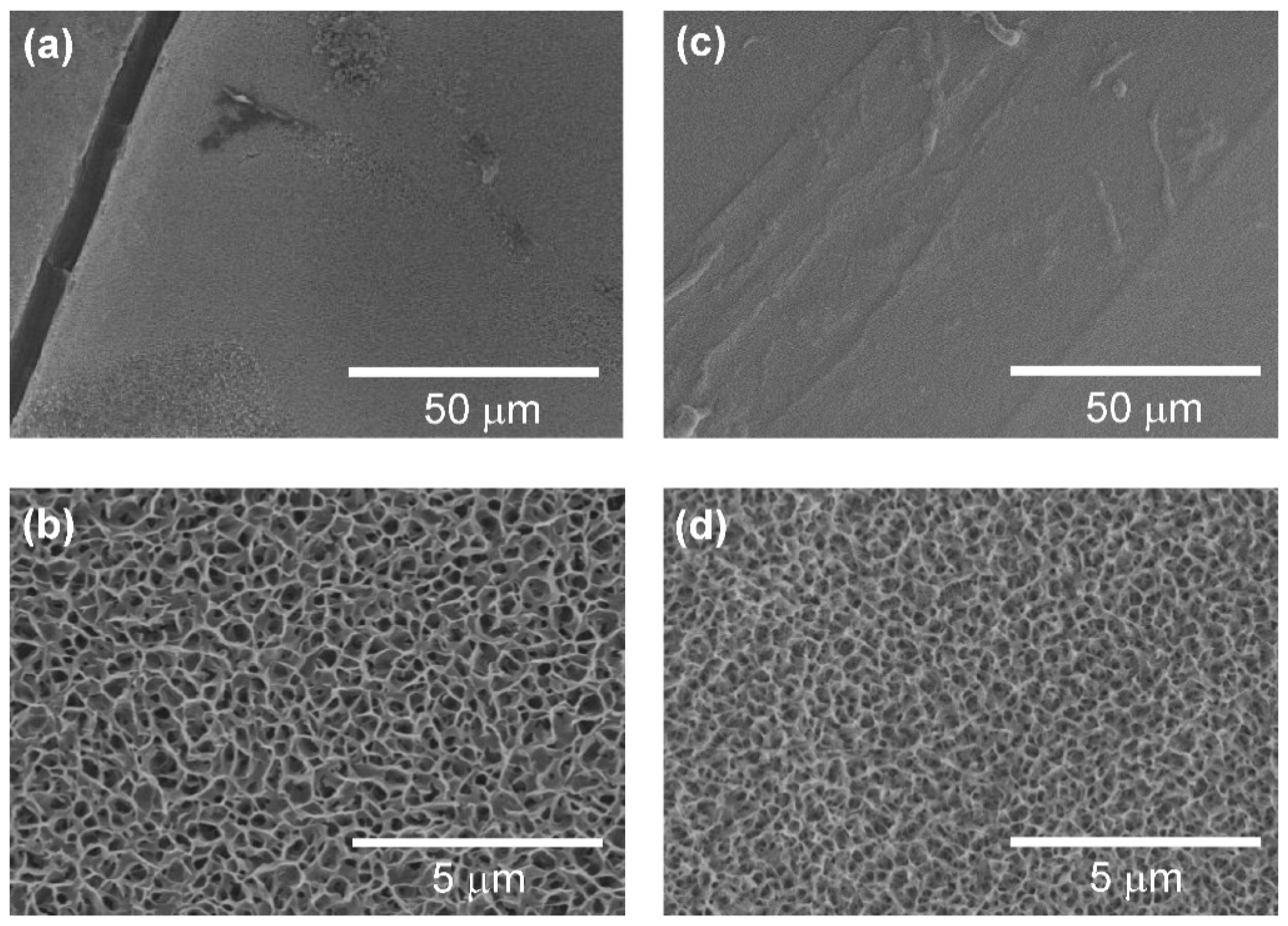
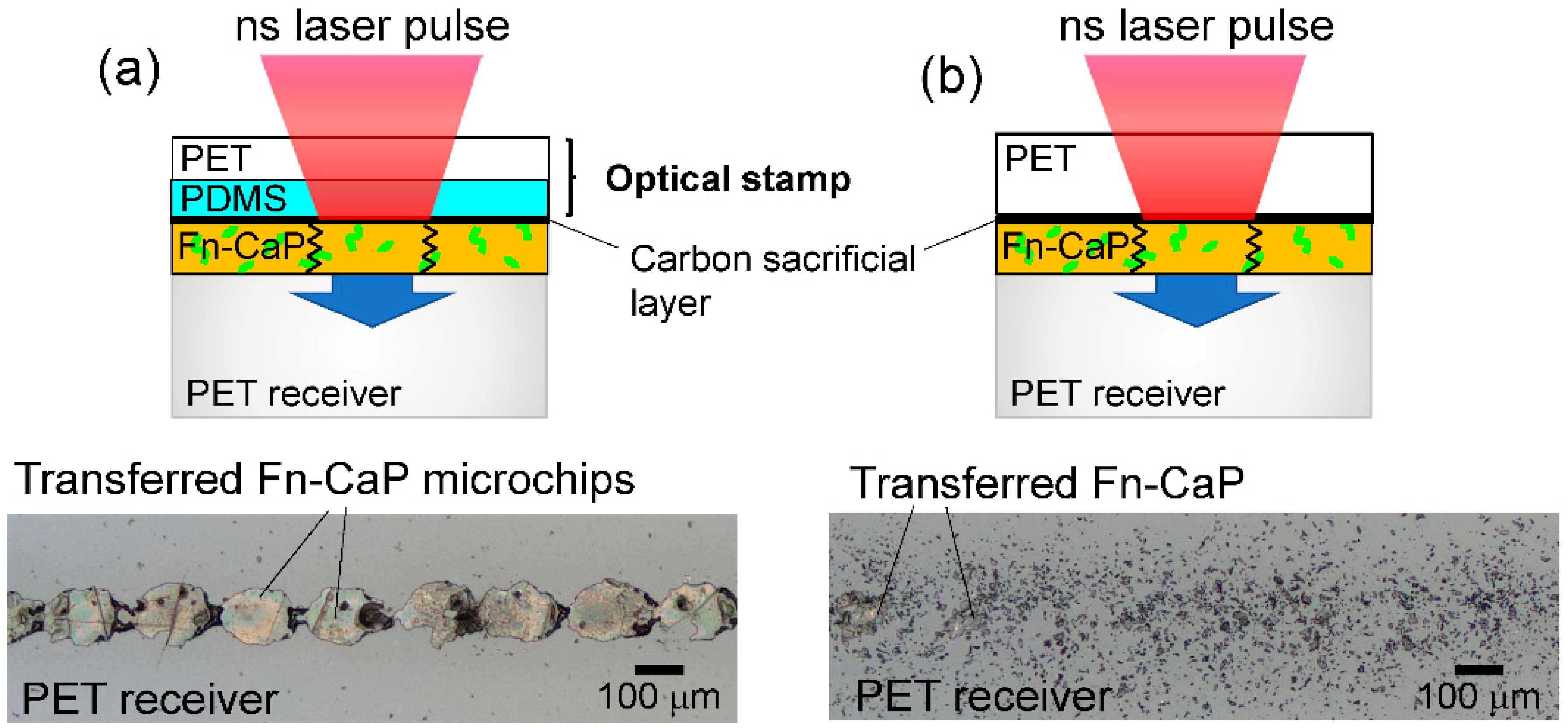
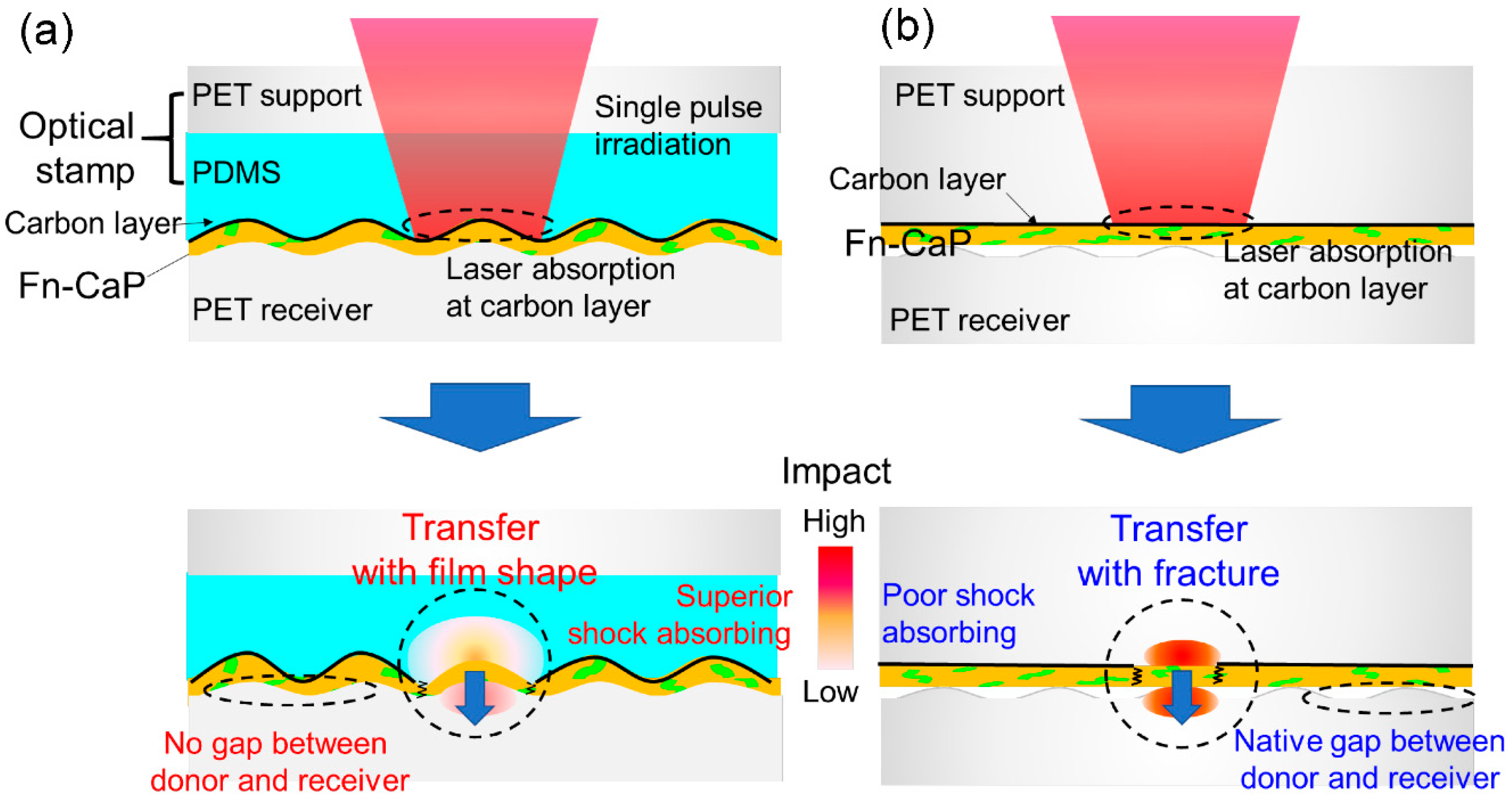
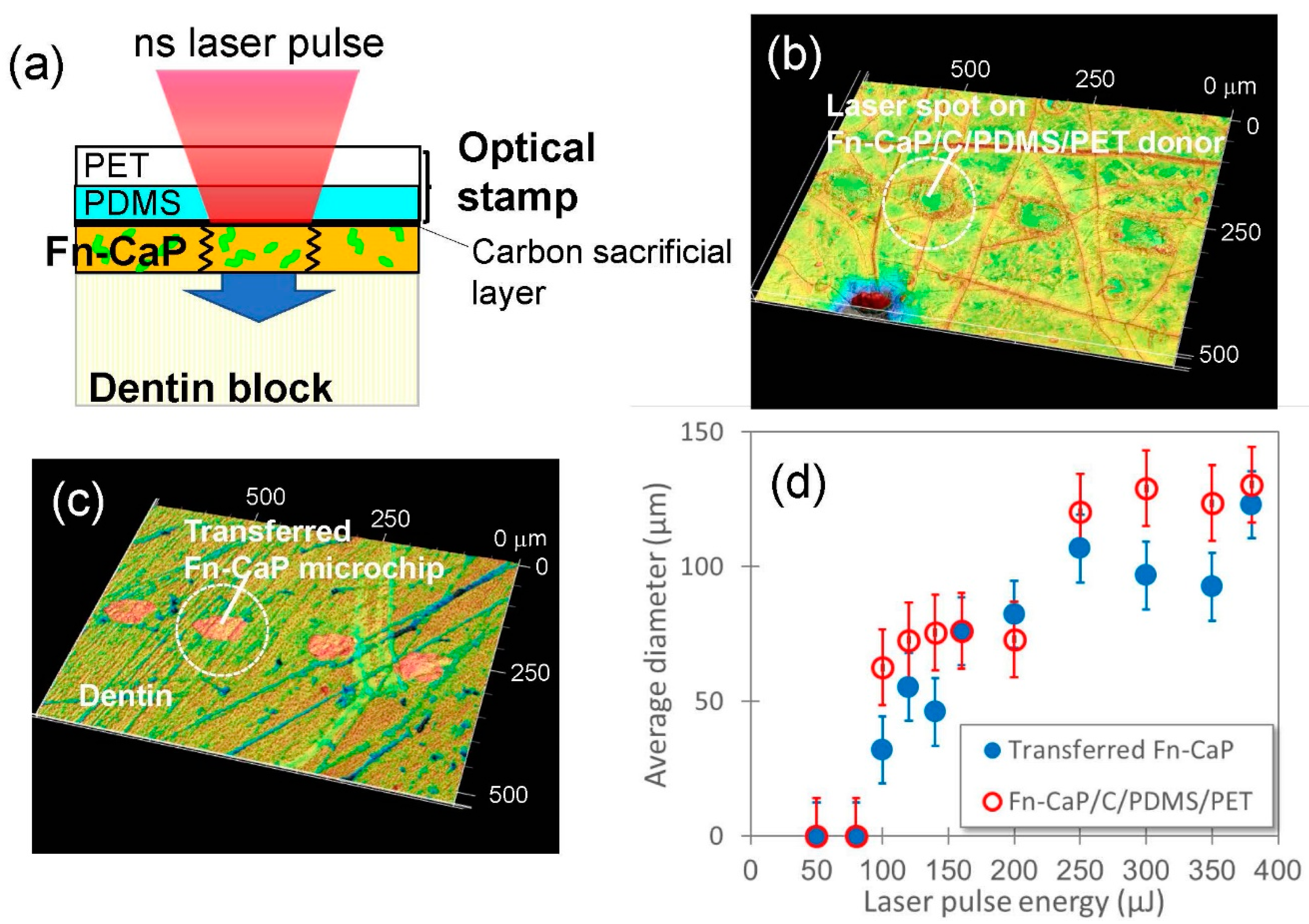
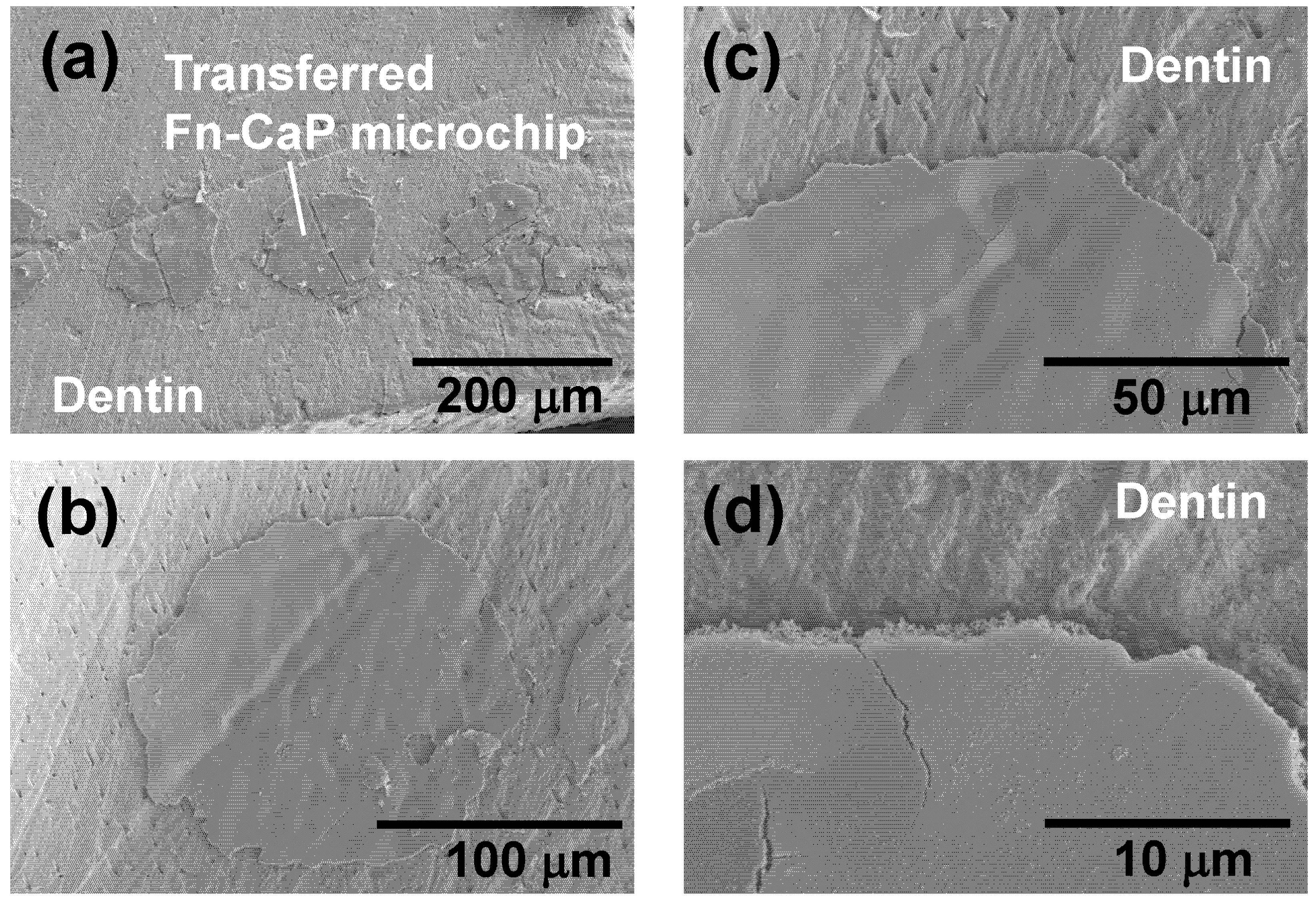
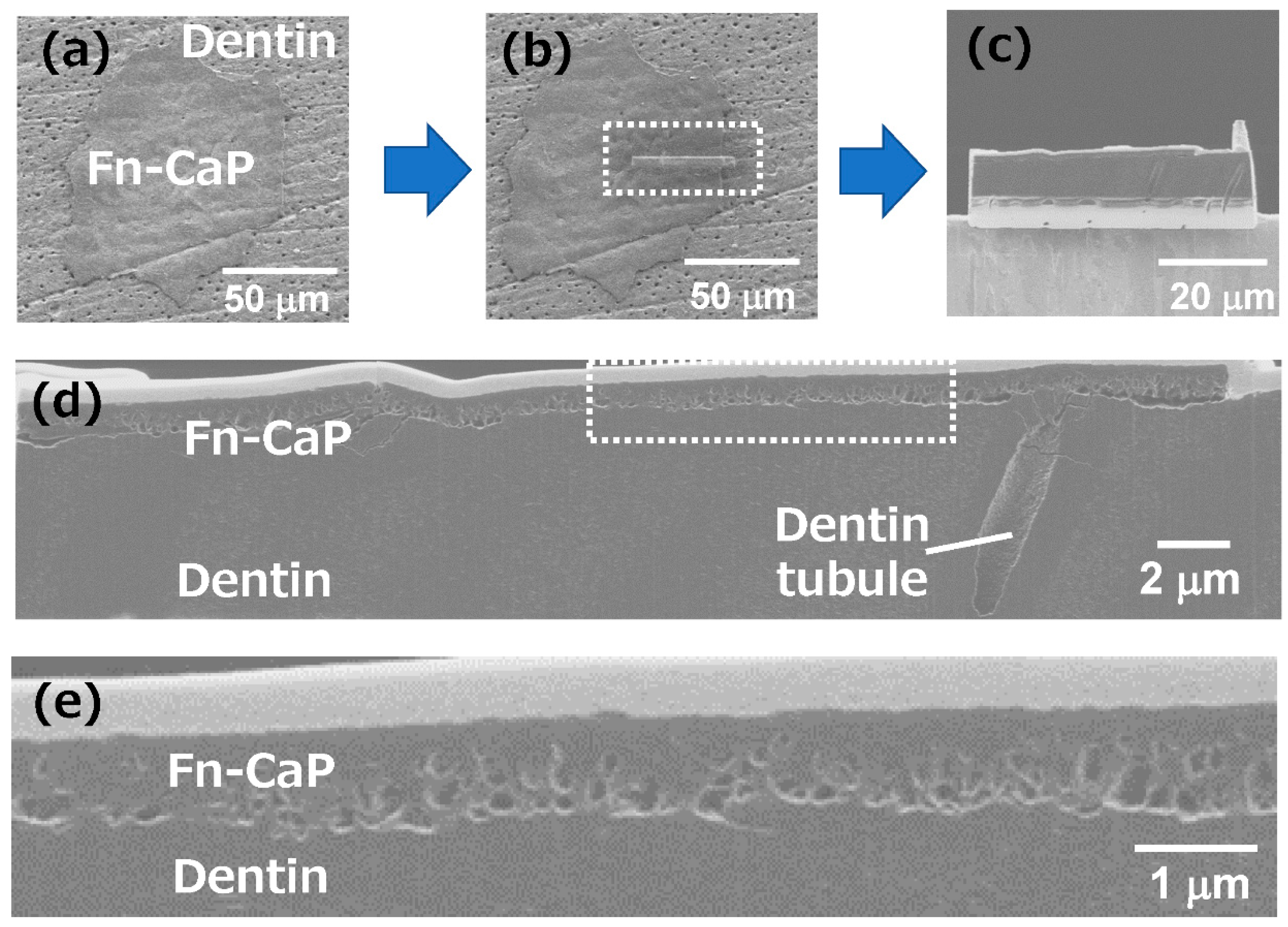
Publisher’s Note: MDPI stays neutral with regard to jurisdictional claims in published maps and institutional affiliations. |
© 2020 by the authors. Licensee MDPI, Basel, Switzerland. This article is an open access article distributed under the terms and conditions of the Creative Commons Attribution (CC BY) license (http://creativecommons.org/licenses/by/4.0/).
Share and Cite
Narazaki, A.; Oyane, A.; Miyaji, H. Laser-Induced Forward Transfer with Optical Stamp of a Protein-Immobilized Calcium Phosphate Film Prepared by Biomimetic Process to a Human Dentin. Appl. Sci. 2020, 10, 7984. https://doi.org/10.3390/app10227984
Narazaki A, Oyane A, Miyaji H. Laser-Induced Forward Transfer with Optical Stamp of a Protein-Immobilized Calcium Phosphate Film Prepared by Biomimetic Process to a Human Dentin. Applied Sciences. 2020; 10(22):7984. https://doi.org/10.3390/app10227984
Chicago/Turabian StyleNarazaki, Aiko, Ayako Oyane, and Hirofumi Miyaji. 2020. "Laser-Induced Forward Transfer with Optical Stamp of a Protein-Immobilized Calcium Phosphate Film Prepared by Biomimetic Process to a Human Dentin" Applied Sciences 10, no. 22: 7984. https://doi.org/10.3390/app10227984
APA StyleNarazaki, A., Oyane, A., & Miyaji, H. (2020). Laser-Induced Forward Transfer with Optical Stamp of a Protein-Immobilized Calcium Phosphate Film Prepared by Biomimetic Process to a Human Dentin. Applied Sciences, 10(22), 7984. https://doi.org/10.3390/app10227984




